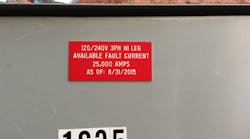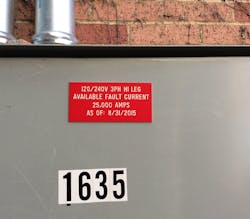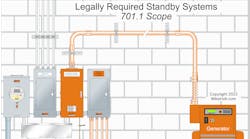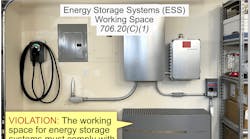I knew I was missing something important when as a mid-level electrical engineer, I used to wonder which voltage value I should be using in my calculations. Was it 110V, 115V, 117V, or 120V? Was it 208V, 220V, 230V, or 240V? Was it 120/240V, 240/120V, 120/208V, 208/120V, 277/480V, or 480/277V?
This sort of practical information was not part of my college curriculum. Part of my confusion came from not understanding that there are three different “flavors” of voltage ratings:
• System voltage: This is the voltage at the low side of the transformer terminals. It is the voltage on which the electrical system has been designed.
• Service voltage: This is the voltage at the boundary where the electric utility provides the source of electrical supply and meters its usage. For a typical residential dwelling where the meter is some distance from the electric utility transformer, the service voltage can be expected to be a little less than the system voltage because of voltage drop.
• Utilization voltage: This is the voltage at the terminals of a device. For a typical plug-connected appliance, the utilization voltage can be expected to be a little less than the service voltage because of voltage drop.
So how the voltage ratings of devices and equipment are determined tend to be different from how system voltages are defined, because they need to consider the expected lower voltage they will likely see at their terminals compared to the full “nominal” value of the system voltage.
There has been a historical race condition, per se, between the service voltage delivered by electric utilities to the customer’s meter and the utilization voltage. As loads on the electric utility systems across the country kept increasing through the 1900s, the voltage drop in the utilities’ distribution systems became higher, which meant a progressively lower voltage was being delivered to customers. To compensate for this voltage drop, electric utilities would raise the voltage level on their system. This required manufacturers to rate their devices and equipment at a slightly higher voltage, because it could potentially receive higher voltage under lightly loaded system conditions.
This discussion will focus on the proper way to write the system voltage for low-voltage systems because I still frequently see it being done incorrectly in design drawings, technical magazines, and equipment placards, thereby demonstrating that at least I was not the only person to be less than informed on this topic.
When I started working as a volunteer on various IEEE standards, it was obvious that I didn’t have it right because I kept getting corrected by the editors at IEEE. However, I still didn’t know the basis for their corrections. I eventually discovered that the electric utility limits for delivering voltage are defined by the standard ANSI C84.1 “Electric Power Systems and Equipment – Voltage Ratings (60 Hz).” Efforts at standardizing system voltages have been going on since the earliest days of electricity, and the culmination of those earlier efforts were captured in this standard, which was first issued in 1954 and most recently updated in 2016. This standard has been pretty much universally adopted by U.S. utilities and Public Utility Commissions as a firm requirement.
ANSI C84.1 not only defines all the various system voltages that are in use, but it also defines the range of service voltage that the electric utility can deliver. For example, the typical 120V power delivered to a residence is allowed a ±5% variation, which yields a range of 114V to 126V. The corresponding minimum utilization voltage is 108V, so plug-connected devices should be designed to operate satisfactorily at this value.
The main Table in ANSI C84.1 is intimidating at first glance. It shows nine different voltages for systems 600V and below, six of which are in bold type to signify they are “preferred.” For medium-voltage systems (2,400V to 69,000V), there are 19 different voltages, nine of which are “preferred.” The most common low-voltage system voltages and how they are correctly written are:
Single-Phase
• 120/240V
3-Phase
• 208Y/120V
• 480Y/277V
• 240/120V
The two most common 3-phase voltages are typically written as 208/120V and 480/277V with most people leaving off the “Y” that is shown in the table, although that is the full, correct way to write it. For 3-phase systems, the highest voltage is written first whereas for single-phase systems, the lowest voltage is written first. The 240/120V 3-phase service is generally not installed today as it is not a “balanced” way of supplying power, although it was common before the 1970s and is still encountered. There is no “Y” in its designation, since it is supplied from a transformer with a delta 3-phase, low-voltage winding, and one of those windings is center-tapped to cut the 240V in half to deliver 120V. Therefore, when you are describing a single-phase supply, it is important to write it as 120/240V because if it is reversed as 240/120V that does imply a 3-phase system.
The Photo shows a label placed by an electric utility at the service meter. Although it doesn’t have it quite right, at least the utility spelled out that it is a 3-phase service. Note that the amount of useful information provided is atypical of most electric utilities and is really nice to see because it saves a lot of time for engineers and contractors not having to call around trying to find the department that can provide the service type and fault current information.
Most electric utilities have developed their own guideline documents based on the voltages of the ANSI C84.1 standard. A simplified, reformatted version by PacifiCorp can be found at www.pacificpower.net/content/dam/pacific_power/doc/Contractors_Suppliers/Power_Quality_Standards/1C_2_1_PF.pdf.
Note: For more information on this topic, including the history of how we arrived at the voltages we have today, see the PDF “Just Exactly Which Voltage Are You Talking About” at the author’s LinkedIn page: https://www.linkedin.com/in/joe-jancauskas-pe-pmp-9a89566/.
Jancauskas is a senior project manager with Mesa Associates, Inc., in Tampa, Fla. He can be reached at [email protected].




